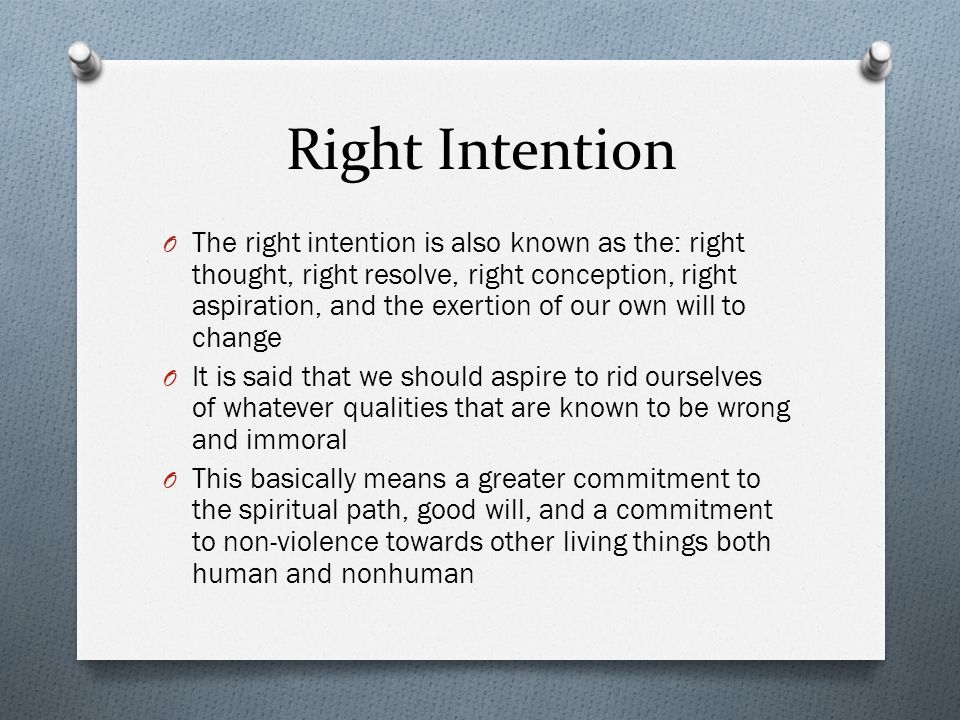Right Intention is the most fundamental thing, which is a great determinant of human life’s destiny. Normally, resolution means being determined in the context of a particular fact. ‘Samyak Sankapp’ in Pali language and ‘Samyak Sankalpa’ in Sanskrit both are synonymous.

The great teachings of Lord Buddha are extremely important in the aspect of right view and right intention under the great eightfold path. Both approaches are interconnected and co-related in a specific way. Right view gives perspective about this great path while right intention gives an action- plan related to following this path. Right view implies right thought, right thought converts to right words and right action, right action leads to right resolve-ultimately leads to happiness in life. On the contrary if the view is not right it ultimately leads to pain and suffering.
Resolve for renunciation

The natural tendencies of a human being remain a lifelong nutrient of countless desires and craving. It is not only a nutrient but also remains a slave to the craving. As long as the tendency of craving is severe, man remains a slave to the mind and senses. One desire does not end, the other is born. The second wish is not fulfilled, the third arises. This cycle of desire and craving continues throughout life. In this cycle of the emergence of desires, the senses are never fully satisfied. Satisfaction is only mistaken in pseudo-form. Right now, the fully-satisfied craving stands up again after a period of time. According to right intention, control is done towards this craving by asceticism or renunciation. The meaning of renunciation or sanyasa doesn’t mean leaving home and related responsibilities and leaving for the forest, but renunciation of worldly craving.
Here Lord Buddha and Yogeshwar Lord Krishna have the same vision. In the Bhagavad-gītā, Lord Shri Krishna explaining to Arjuna, says –
“śhrī bhagavān uvācha-
” asanśhayaṁ mahā-bāho mano durnigrahaṁ chalam
abhyāsena tu kaunteya vairāgyeṇa cha gṛihyate”||6.35||

That is to say, Sri Bhagavan says – Oh dear! Of course, the mind is fickle and difficult to tame; But, O Kuntiputra! It can be tamed by practice and renunciation.
Resolve for good will

Maliciousness or ill-will is a serious negative tendency of mind. Both the positive and negative forms of thoughts exist simultaneously inside the human mind. Lord Buddha had thoughts of both goodwill and ill-will in the mind at the time of meditation before experiencing the ultimate knowledge. Thoughts such as maliciousness, ill-will, jealousy of others ultimately lead to sorrow and suffering in life. Whereas positive thoughts like goodwill or harmony towards others ultimately destroy the craving and make life free from the bondage which leads to happiness.
Metta-Bhavana

Buddhists use “Metta-Bhavana” for the welfare of humanity. Under the Metta-Bhavana, a sense of love and compassion towards others is followed from the hearts. The first thing is to ensure one’s own welfare under the Metta-Bhavna. After that, prayers are offered for the welfare of others and the welfare of the whole world. The recognition of ” Vasudhaiva Kutumbakam” is embedded in this spirit.
Resolve for harmlessness
In negative tendencies of the mind, there is some kind of harm to others in one form or the other. When a person causes harm to another human being or an animal by the mind, speech, physical act or causes for their grief or suffering in any way, then such karmas automatically gets involved in the inventory of bad karmas and in the period of time bring its results.

Man needs a special awareness of his deeds. Any kind of karmas should not be harmful in any form to anyone. Whereas harmless karmas and that related resolve should have a place in life. Desire and craving are harmful factors for others. As soon as craving is destroyed, the harmful instinct converts in love, compassion and well-being of others, which is a real resolve for harmlessness.
courtesy : google images





